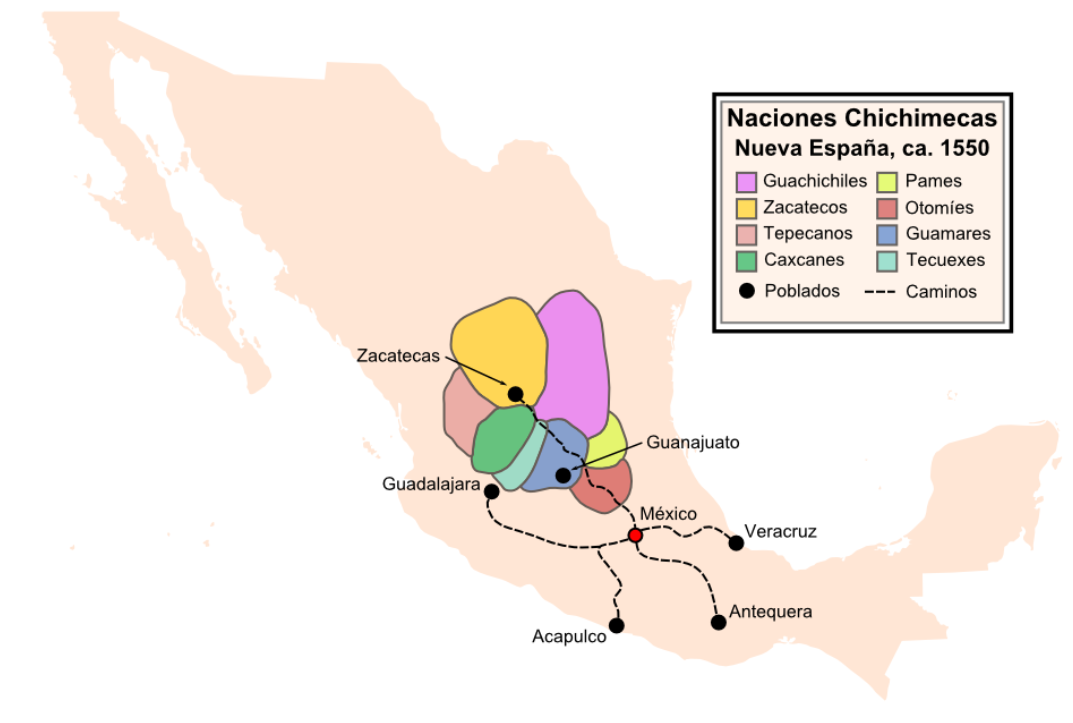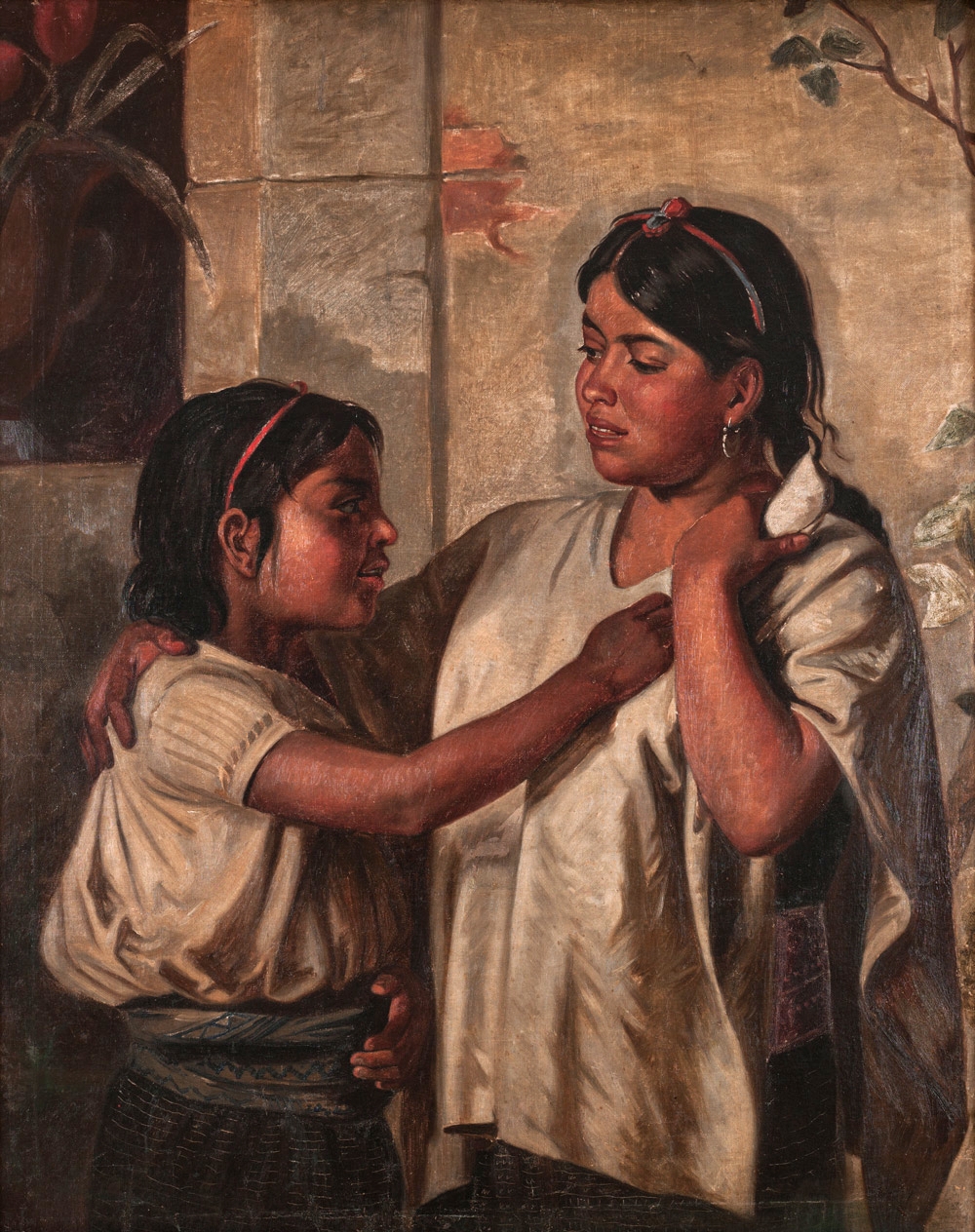|
Guamare
The Guamare people were an indigenous people of Mexico, who were established mostly in Guanajuato and at the border of Jalisco. They were part of the Chichimecas, a group of a nomadic hunter-gatherer culture and called themselves Children of the Wind, living religiously from the natural land. As a tradition, they would cremate their dead and spread their ashes into the wind back to 'Mother Earth'. The Guamare people were politically united with the Chichimeca Confederation, but like other Chichimeca nations were independent. The Chichimeca were established in the present-day Bajio region of Mexico. Territory The Guamares were centered in the Guanajuato Sierras, but some settled as far east as Aguascalientes. The 17th century author Gonzalo de las Casas described the Guamares as "the bravest, most warlike, treacherous and destructive of all the Chichimecas, and the most astute (dispuesta)."Powell 38 One Guamare group called the "Chichimecas Blancos" lived in the region between ... [...More Info...] [...Related Items...] OR: [Wikipedia] [Google] [Baidu] |
Chichimeca War
The Chichimeca War (1550–90) was a military conflict between the Spanish Empire and the Chichimeca Confederation established in the territories today known as the Central Mexican Plateau, called by the Conquistadores La Gran Chichimeca. The epicenter of the hostilities was the region now called the Bajío. The Chichimeca War is recorded as the longest and most expensive military campaign confronting the Spanish Empire and indigenous people in Mesoamerica. The forty-year conflict was settled through several peace treaties driven by the Spaniards which led to the pacification and, ultimately, the streamlined integration of the native populations into the New Spain society. The Chichimeca War (1550-1590) began eight years after the two-year Mixtón War. It can be considered a continuation of the rebellion as the fighting did not come to a halt in the intervening years. Unlike in the Mixtón rebellion, the Caxcanes were now allied with the Spanish. The war was fought in what ... [...More Info...] [...Related Items...] OR: [Wikipedia] [Google] [Baidu] |
Guanajuato
Guanajuato (), officially the Free and Sovereign State of Guanajuato ( es, Estado Libre y Soberano de Guanajuato), is one of the 32 states that make up the Federal Entities of Mexico. It is divided into 46 municipalities and its capital city is Guanajuato. Guanajuato is in central Mexico. It is bordered by the states of Jalisco to the west, Zacatecas to the northwest, San Luis Potosí to the north, Querétaro to the east, and Michoacán to the south. It covers an area of . The state is home to several historically important cities, especially those along the "Bicentennial Route", which retraces the path of Miguel Hidalgo y Costilla's insurgent army at the beginning of the Mexican War of Independence. This route begins at Dolores Hidalgo, and passes through the Sanctuary of Atotonilco, San Miguel de Allende, Celaya, and the capital of Guanajuato. Other important cities in the state include León, the state's biggest city, Salamanca, and Irapuato. The first town establi ... [...More Info...] [...Related Items...] OR: [Wikipedia] [Google] [Baidu] |
Jalisco
Jalisco (, , ; Nahuatl: Xalixco), officially the Free and Sovereign State of Jalisco ( es, Estado Libre y Soberano de Jalisco ; Nahuatl: Tlahtohcayotl Xalixco), is one of the 31 states which, along with Mexico City, comprise the 32 Federal Entities of Mexico. It is located in Western Mexico and is bordered by six states, which are Nayarit, Zacatecas, Aguascalientes, Guanajuato, Michoacán, and Colima. Jalisco is divided into 125 municipalities, and its capital and largest city is Guadalajara. Jalisco is one of the most economically and culturally important states in Mexico, owing to its natural resources as well as its long history and culture. Many of the characteristic traits of Mexican culture, particularly outside Mexico City, are originally from Jalisco, such as mariachi, ranchera music, birria, tequila, jaripeo, etc., hence the state's motto: "Jalisco es México." Economically, it is ranked third in the country, with industries centered in the Guadalajara ... [...More Info...] [...Related Items...] OR: [Wikipedia] [Google] [Baidu] |
Guachichiles
The Guachichil, Cuauchichil, or Quauhchichitl, are an Indigenous people of Mexico. Pre-contact, they occupied the most extensive territory of all the indigenous Chichimeca Nations tribes in pre-Columbian Central Mexico. The Guachichiles roamed through a large region of Zacatecas; as well as portions of San Luis Potosí, Guanajuato, and northeastern Jalisco; south to the northern corners of Michoacán; and north to Saltillo in Coahuila. The Guachichil Nation continues to exist in the city of San Luis Potosi, San Luis Potosi, Mexico, and is recognized by the city and state. They have tribal members in Mexico and the United States. History Considered both warlike and brave, the Guachichiles played a major role in provoking the other Chichimeca tribes to resist the Spanish settlement. The historian Philip Wayne Powell wrote: :::" ''Their strategic position in relation to Spanish mines and highways, made them especially effective in raiding and in escape from Spanish reprisal''." ... [...More Info...] [...Related Items...] OR: [Wikipedia] [Google] [Baidu] |
Mexico
Mexico ( Spanish: México), officially the United Mexican States, is a country in the southern portion of North America. It is bordered to the north by the United States; to the south and west by the Pacific Ocean; to the southeast by Guatemala, Belize, and the Caribbean Sea; and to the east by the Gulf of Mexico. Mexico covers ,Mexico '' The World Factbook''. . making it the world's 13th-largest country by area; with approximately 12 ... [...More Info...] [...Related Items...] OR: [Wikipedia] [Google] [Baidu] |
Chichimecas
Chichimeca () is the name that the Nahua peoples of Mexico generically applied to nomadic and semi-nomadic peoples who were established in present-day Bajio region of Mexico. Chichimeca carried the meaning as the Roman term "barbarian" that described Germanic tribes. The name, with its pejorative sense, was adopted by the Spanish Empire. For the Spanish, in the words of scholar Charlotte M. Gradie, "the Chichimecas were a wild, nomadic people who lived north of the Valley of Mexico. They had no fixed dwelling places, lived by hunting, wore little clothes and fiercely resisted foreign intrusion into their territory, which happened to contain silver mines the Spanish wished to exploit." In spite of not having temples or idols, they practiced animal sacrifice, and they were feared for their expertise and brutality in war. The Spanish invasion resulted in a "drastic population decline of all the peoples known collectively as Chichimecas, and to the eventual disappearance as peoples ... [...More Info...] [...Related Items...] OR: [Wikipedia] [Google] [Baidu] |
Indigenous People Of Mexico
Indigenous peoples of Mexico ( es, gente indígena de México, pueblos indígenas de México), Native Mexicans ( es, nativos mexicanos) or Mexican Native Americans ( es, pueblos originarios de México, lit=Original peoples of Mexico), are those who are part of communities that trace their roots back to populations and communities that existed in what is now Mexico before the arrival of the Spanish. The number of indigenous Mexicans is defined through the second article of the Constitution of Mexico, Mexican Constitution. The Censo General de Población y Vivienda, Mexican census does not classify individuals by race, using the Culture, cultural-Ethnic group, ethnicity of indigenous communities that preserve their Indigenous language, indigenous languages, traditions, beliefs, and cultures. According to the National Indigenous Institute (INI) and the National Institute of Indigenous Peoples (CDI), in 2012 the indigenous population was approximately 15 million people, divided into ... [...More Info...] [...Related Items...] OR: [Wikipedia] [Google] [Baidu] |
Aguascalientes
Aguascalientes (; ), officially the Free and Sovereign State of Aguascalientes ( es, Estado Libre y Soberano de Aguascalientes), is one of the 32 states which comprise the Federal Entities of Mexico. At 22°N and with an average altitude of above sea level it is predominantly of semi-arid climate ( Bhs and Bhk), and it is located in the northern part of the Bajío region, in north-central Mexico, bordered by Zacatecas to the north, east and west, and by Jalisco to the south. As of 2019, Aguascalientes has a population of 1.4 million inhabitants, most of whom live in its capital city, also named Aguascalientes. Its name means "hot waters" and originated from the abundance of hot springs originally found in the area. The demonym for the state's inhabitants is ''hidrocálido'' or ''aguascalentense''. Aguascalientes is one of the smallest states of Mexico, either by population or land, being the 27th most populated state and the 29th biggest state by area; nonetheless, it is the ... [...More Info...] [...Related Items...] OR: [Wikipedia] [Google] [Baidu] |
Gonzalo De Las Casas , a name
{{disambiguation, geo ...
Gonzalo may refer to: * Gonzalo (name) * Gonzalo, Dominican Republic, a small town * Isla Gonzalo, a subantarctic island operated by the Chilean Navy * Hurricane Gonzalo, 2014 See also * Gonzalez (other) * Gonzales (other) * Gonsalves (other) * Gonçalves Gonçalves (; Portuguese for "son of Gonçalo") is a Portuguese surname. Notable people with the surname include: * Adílio de Oliveira Gonçalves (born 1956), Brazilian footballer * Ailton Goncalves da Silva (born 1973), Brazilian footballer * ... [...More Info...] [...Related Items...] OR: [Wikipedia] [Google] [Baidu] |


